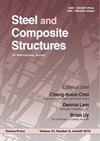Axial capacity of back-to-back built-up cold-formed stainless steel unlipped channels-Numerical investigation and parametric study
IF 4
3区 工程技术
Q1 CONSTRUCTION & BUILDING TECHNOLOGY
引用次数: 14
Abstract
In cold-formed steel structures, such as trusses, wall frames and portal frames, the use of back-to-back built-up cold-formed stainless steel unlipped channels as compression members are becoming popular. The advantages of using stainless steel as structural members are corrosion resistance and durability, compared with carbon steel. Current guidance by the American Iron and Steel Institute (AISI) and the Australian and New Zealand (AS/NZS) standards for built-up carbon steel sections describes a modified slenderness approach, to consider the spacing of the intermediate fasteners. The AISI and AS/NZS do not include the design of stainless-steel built-up channels and very few experimental tests or finite element (FE) analyses have been reported in the literature for such back-to-back cold-formed stainless steel unlipped channel section columns. This paper presents a numerical investigation on the behavior of back-to-back built-up cold-formed stainless steel unlipped channel section columns. Three different grades of stainless steel i.e., duplex EN1.4462, ferritic EN1.4003 and austenitic EN1.4404, were considered. The effects of screw spacing on the axial strength of such built-up unlipped channels were investigated. As expected, most of the short and intermediate columns failed by either local-global or local-distortional buckling interactions, whereas the long columns failed by global buckling. All three grades of stainless-steel stub columns failed by local buckling. A comprehensive parametric study was then carried out covering a wide range of slenderness and different cross-sectional geometries to assess the performance of the current design guidelines of carbon steel built-up sections in accordance with the AISI and AS/NZS. In total, 647 FE models were analyzed. From the results of the parametric study, it was found that the AISI and AS/NZS are conservative by around 14 to 20% for all three grades of stainless steel built-up unlipped channel section columns failed through global buckling. However, the AISI and AS/NZS carbon steel design rules can be un-conservative by around 8 to 13%, when they are used to calculate the axial capacity of those stainless steel built-up unlipped channels which are failed in local buckling.背靠背组合冷弯不锈钢无唇通道轴向承载力的数值研究与参数化研究
在冷弯型钢结构中,如桁架、墙框架和门式框架,使用背靠背的冷弯不锈钢非唇形通道作为压缩构件正变得越来越流行。与碳钢相比,采用不锈钢作为结构构件的优点是耐腐蚀和耐用。目前,美国钢铁协会(AISI)和澳大利亚和新西兰(AS/NZS)标准的指南描述了一种改进的长细度方法,以考虑中间紧固件的间距。AISI和AS/NZS不包括不锈钢组合通道的设计,文献中很少报道这种背靠背冷弯不锈钢非唇形通道截面柱的实验测试或有限元分析。本文对背靠背组合冷弯不锈钢无唇槽截面柱的性能进行了数值研究。考虑了三种不同等级的不锈钢,即双相EN1.4462、铁素体EN1.4003和奥氏体EN1.4404。研究了螺杆间距对非唇形通道轴向强度的影响。正如预期的那样,大多数短柱和中间柱的失稳是局部-全局或局部扭曲的相互作用造成的,而长柱的失稳是整体失稳。三个等级的不锈钢短柱均因局部屈曲而失效。然后进行了一项全面的参数研究,涵盖了广泛的长细比和不同的横截面几何形状,以根据AISI和AS/NZS评估碳钢组合截面当前设计指南的性能。共分析了647个有限元模型。从参数化研究的结果来看,对于所有三个等级的不锈钢组合无口槽截面柱,AISI和AS/NZS的保守值约为14%至20%。然而,当AISI和AS/NZS碳钢设计规则用于计算那些在局部屈曲中失效的不锈钢非开口通道的轴向承载力时,它们的不保守性约为8%至13%。
本文章由计算机程序翻译,如有差异,请以英文原文为准。
求助全文
约1分钟内获得全文
求助全文
来源期刊

Steel and Composite Structures
工程技术-材料科学:复合
CiteScore
8.50
自引率
19.60%
发文量
0
审稿时长
7.5 months
期刊介绍:
Steel & Composite Structures, An International Journal, provides and excellent publication channel which reports the up-to-date research developments in the steel structures and steel-concrete composite structures, and FRP plated structures from the international steel community. The research results reported in this journal address all the aspects of theoretical and experimental research, including Buckling/Stability, Fatigue/Fracture, Fire Performance, Connections, Frames/Bridges, Plates/Shells, Composite Structural Components, Hybrid Structures, Fabrication/Maintenance, Design Codes, Dynamics/Vibrations, Nonferrous Metal Structures, Non-metalic plates, Analytical Methods.
The Journal specially wishes to bridge the gap between the theoretical developments and practical applications for the benefits of both academic researchers and practicing engineers. In this light, contributions from the practicing engineers are especially welcome.
 求助内容:
求助内容: 应助结果提醒方式:
应助结果提醒方式:


